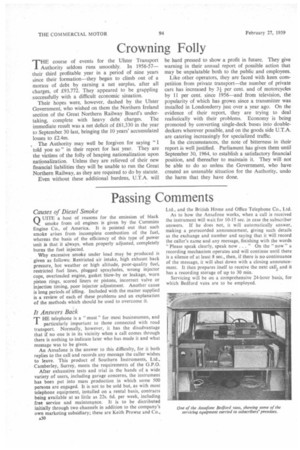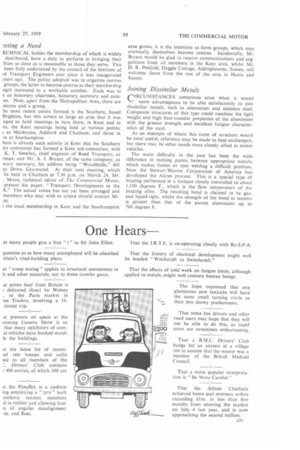Passing Comments
Page 32

Page 33

If you've noticed an error in this article please click here to report it so we can fix it.
Causes of Diesel Smoke
UITE a host of reasons for the emission of black smoke from oil engines is given by the Cummins Engine Co., of America. It is pointed out that such smoke arises from incomplete combustion of the fuel, whereas the basis of the efficiency of this type of power unit is that it always, when properly adjusted, completely burns the fuel injected.
Why excessive smoke under load may be produced is given as follows: Restricted air intake, high exhaust back pressure, hot weather or high altitude, poor-quality fuel, restricted fuel lines, plugged sprayholes, wrong injector cups, overloaded engine, gasket blow-by or leakage, worn piston rings, scored liners or pistons, incorrect valve or injection timing, poor injector adjustment. Another cause is long periods of idling. Included with the matter supplied is a review of each of these problems and an explanation of the methods which should be used to overcome it.
It Answers Back
T HE telephone is a " must " for most businessmen, and
particularly important to those connected with road transport. Normally, however, it has the disadvantage that if no one is in its vicinity when a call comes through there is nothing to indicate later who has made it and what message was to be given.
An Ansafone is the answer to this difficulty, for it both replies to the call and records any message the caller wishes to leave. This product of Southern Instruments, Ltd., Camberley, Surrey, meets the requirements of the G.P.O.
After exhaustive tests and trial in the hands of a wide variety of users, including garage concerns, the instrument has been put into mass production in which some 500 persons are engaged. It is not to be sold but, as with most telephone equipment, installed on a rental basis, contracts being available at as little as 22s. 6d. per week, including free service and maintenance. It is to be distributed initially through two channels in addition to the company's own marketing subsidiary; these are Keith Prowse and Co., A30 Ltd., and the British Home and Office Telephone Co., Ltd.
As to how the Ansafone works, when a call is received the instrument will wait for 10-15 sec. in case the subscriber answers. If he does not, it will automatically answer, making a prerecorded announcement, giving such details as the exchange and number and saying that it will record the caller's name and any message, finishing with the words "Please speak clearly, speak now ... " On the " now " a recording mechanism operates and will continue until there is a silence of at least 8 sec., then, if there is no continuance of the message, it will shut down with a closing announcement. It then prepares itself to receive the next call, and it has a recording storage of up to 30 min.
Servicing will be on a comprehensive 24-hour basis, for which Bedford vans are to be employed.
?wing a Need
ECHNICAL bodies the membership of which is widely distributed, have a duty to perform in bringing their lities as close as is reasonable to those they serve. This been fully understood by the council of the Institute of td Transport Engineers ever since it was inaugurated years ago. The policy adopted was to organize centres groups, the latter to become centres as their membership ngth increased to a workable number. Each was to e an honorary chairman, honorary secretary and corn:ee. Now, apart from the Metropolitan Area, there are ;entres and a group.
he most recent centre formed is the Southern, based Brighton, but this covers so large an area that it was nged to hold meetings in turn there, in Kent and in its, the Kent meetings being held At various points, t as Maidstone, Ashford and Chatham, and those in ts at Southampton.
here is already such activity in Kent that the Southern tre committee has formed a Kent sub-committee, with K. T. Smalley, chief engineer of Reed Transport, as rman, and Mr. A. J. Bryant, of the same company, as 3rary secretary, his address being " Woodfields," 401 ey Drive, Gravesend. At their next meeting, which be held in Chatham at 7.30 p.m. on March 24, Mr. . Moon, technical editor of The Commercial Motor, present his paper, " Transport Developments in the A." The actual venue has not yet been arranged and members-who may wish to attend should contact Mr. .nt.
; the local membership in Kent and the Southampton area grows, it is the intention to form groups, which may eventually themselves become centres. Incidentally, Mr. Bryant would be glad to receive communications and suggestions from all members in the Kent area, whilst Mr. D. R. Penfold, Daggle Cottage, Aldingbourne, Sussex, will welcome those from the rest of the area in Hants and Sussex.
Joining Dissimilar Metals
CIRCUMSTANCES sometimes arise when it would
seem advantageous to be able satisfactorily to join dissimilar metals, such as aluminium and stainless steel. Composite structures of this type could combine the light weight and high heat-transfer properties of the aluminium with the greater strength and excellent fatigue characteristics of the steel.
As an example of where this form of structure would be most useful, reference may be made to heat-exchangers, but there may be other needs more closely allied to motor vehicles.
The main difficulty in the past has been the wide difference in melting points between appropriate metals, which makes fusion or spot welding a difficult problem. Now the Stewart-Warner Corporation of America has developed the Alcres process. This is a special type of brazing performed in a furnace closely controlled to about 1,100 degrees F., which is the flow temperature of the brazing alloy. The resulting bond is claimed to be gasand liquid-tight, whilst the strength of the bond in tension is greater than that of the parent aluminium up to 760 degrees F.




































































































